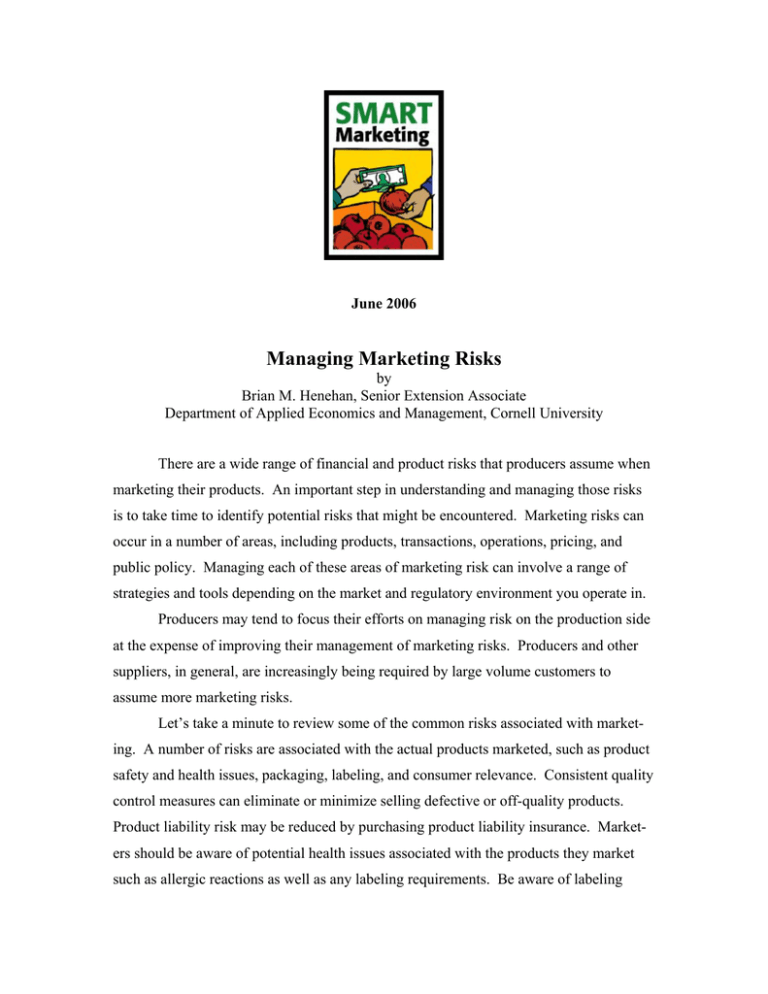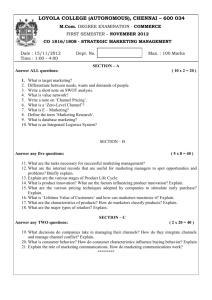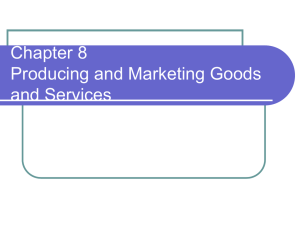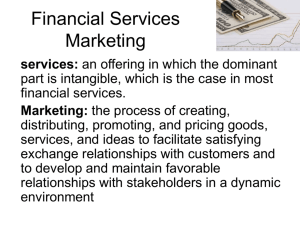Managing Marketing Risks
advertisement

June 2006 Managing Marketing Risks by Brian M. Henehan, Senior Extension Associate Department of Applied Economics and Management, Cornell University There are a wide range of financial and product risks that producers assume when marketing their products. An important step in understanding and managing those risks is to take time to identify potential risks that might be encountered. Marketing risks can occur in a number of areas, including products, transactions, operations, pricing, and public policy. Managing each of these areas of marketing risk can involve a range of strategies and tools depending on the market and regulatory environment you operate in. Producers may tend to focus their efforts on managing risk on the production side at the expense of improving their management of marketing risks. Producers and other suppliers, in general, are increasingly being required by large volume customers to assume more marketing risks. Let’s take a minute to review some of the common risks associated with marketing. A number of risks are associated with the actual products marketed, such as product safety and health issues, packaging, labeling, and consumer relevance. Consistent quality control measures can eliminate or minimize selling defective or off-quality products. Product liability risk may be reduced by purchasing product liability insurance. Marketers should be aware of potential health issues associated with the products they market such as allergic reactions as well as any labeling requirements. Be aware of labeling regulations - descriptive terms such as “organic” can only be used if the product is certified to meet that definition. Although less tangible than other types of marketing risks, the possible decline of product relevance to consumers should be an ongoing concern for smart marketers. Staying in touch with the wants and needs of consumers can be a full-time job. With ever-changing purchasing patterns, eating habits, dietary fads, and shifting demographics, maintaining product relevance can be a challenge. It is essential to understand how relevant your products are to today’s consumers. Transaction risks can include customer payment defaults, disregard of agreedupon terms of trade, or limited legal protection. Producers may be protected by government programs or regulations when marketing certain products. Some states require buyers to be bonded or provide letters of credit to be licensed to buy farm products. Other states may have producer security funds that might offer some protection if a buyer defaults or declares bankruptcy. If you have doubts about the credit-worthiness of a particular customer, there are research services that provide credit ratings for firms, or state agencies that might offer valuable information about a buyer’s payment history. Contractual arrangements that spell out the responsibilities of both marketers and customers may be useful in managing transactional risk. Be prepared to implement a “Cash on Delivery” policy for customers who have poor credit history or have exceeded agreedupon payment terms. Be clear on when the title for your farm products changes hands and becomes the property and responsibility of your customer. And keep good records with clear terms of sale for each transaction. Operational risks can include a wide range of activities associated with marketing a product, such as grading or processing, shipping and transportation. Operational risks can be minimized by instituting uniform policies for those involved in handling, processing, or selling your products. Various types of insurance products may be useful for protecting against operational or transportation accidents. Identify “pressure points” in your marketing operations where you may incur risks. What risks may be associated with hosting customers on your farm or at your farmers’ market? How will you manage breakdowns in transporting perishable products or shrinkage in inventory? 2 Pricing risks can be associated with volatile markets, customer market power, or seasonal fluctuations. A number of agricultural commodities are traded on futures markets that allow marketers to decrease price risks, but most specialty crops are not publicly traded. The increasing market power of retail and food service firms and an intense focus on supply chain management and cost cutting are putting pressure on ALL suppliers to offer more services, assume more risk, eliminate costs and share marketing expenses. Contractual arrangements with buyers may be a useful tool to minimize longer term or seasonal pricing risks. There are relatively new types of crop insurance products (Adjusted Gross Revenue and Adjusted Gross Revenue Lite) available to producers that can help protect against revenue losses, including low prices. Unanticipated changes in public policy can create risks in any of the former categories of risks such as labeling requirements, regulations affecting employees or transportation systems, government sponsored producer security funds or producer price support programs. Monitoring potential, detrimental changes in public policy can be a fulltime job. There can be a valuable role for producer groups or associations to monitor and influence public policy. To summarize, marketing any product involves risks. Smart marketers understand the risks they will encounter along the way and then develop management strategies to eliminate or minimize marketing risks. There can be “win-win” strategies to minimize marketing risks to both sellers and buyers. Those who can successfully manage risks will be in a much better position to reap the rewards. "Smart Marketing" is a monthly marketing newsletter for extension publication in local newsletters and for placement in local media. It reviews the elements critical to successful marketing in the food and agricultural industry. Articles are written by faculty members in the Department of Applied Economics and Management at Cornell University. "Share the gift of communication." Please cite or acknowledge when using this material. 3






